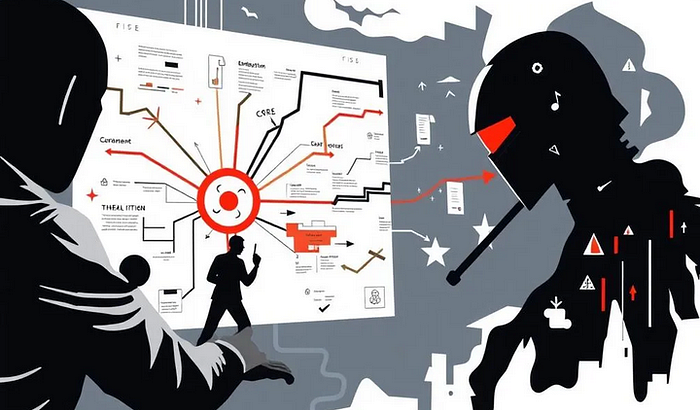Imagine building a house without checking for weak spots — no locks on the doors, no windows that actually close. That's what developing software without threat modeling looks like.
Threat modeling is basically your blueprint for thinking like an attacker before the bad guys do. It's the practice of identifying potential security risks in your systems before they turn into real vulnerabilities. Let's break it down — no jargon, no fluff.
What Exactly Is Threat Modeling?
Threat modeling is like a security "health check" for your applications or systems. It helps you figure out:
- What could go wrong
- How it could happen
- And what you can do to stop it
It's a structured, proactive approach to spotting weaknesses early in the development lifecycle — before your code ever goes live. By doing this, your team avoids the pain (and cost) of patching preventable security issues later.
How Does It Actually Work?
Instead of reacting to incidents after they happen, threat modeling helps you stay ahead of attackers. Here's what it typically involves:
- Identify potential attackers and motives. Who might target your app — and why?
- Map your system. Visualize your architecture, data flows, and entry points.
- Spot weaknesses. Look for areas where an attacker could sneak in or disrupt things.
- Simulate real-world threats. Think of it as a "what if hackers tried this?" exercise.
By anticipating how someone could exploit your system, you can prioritize and fix risks early — integrating security into every step of your SDLC (Software Development Lifecycle).
Why Threat Modeling Is a Game-Changer
Threat modeling doesn't just make your app safer — it makes your whole team stronger.
✅ Proactive security: Catch risks early before they become expensive problems. ✅ Smarter resource use: Focus on high-impact vulnerabilities first. ✅ Better collaboration: Bring developers, architects, and security engineers together. ✅ Stronger designs: Build security into your system, not around it. ✅ Continuous improvement: Stay ahead of new threats as they evolve.
The result? You don't just fix bugs — you design smarter systems from the ground up.
The Threat Modeling Process (In 3 Simple Steps)
- Model the System — Identify assets, sketch your architecture, and define data flows.
- Analyze Threats — Use frameworks to find possible attack vectors and weak spots.
- Prioritize and Mitigate — Rank risks by severity and design your defense strategy.
That's it. You don't need a PhD in security to start — just a clear understanding of your system and a methodical mindset.
Popular Frameworks You Can Use
If you're wondering where to start, you're in good company. Here are the industry favorites:
- STRIDE — Categorizes threats like Spoofing, Tampering, and Denial of Service.
- DREAD — Helps prioritize risks based on Damage, Reproducibility, and more.
- OCTAVE — Focuses on business impact, not just technical vulnerabilities.
- PASTA — Uses attack simulations to align threats with business goals.
- TRIKE — Builds risk models based on assets and controls.
- VAST — Designed for modern Agile and DevOps workflows.
- NIST — Offers a compliance-friendly, structured approach to risk management.
Threat Modeling Tools Worth Exploring
You don't have to do it all manually. Here are a few tools that make life easier:
- Microsoft Threat Modeling Tool — Drag-and-drop diagrams, easy to visualize threats.
- OWASP Threat Dragon — Open-source and great for visual workflows.
Both help you visualize APIs, data stores, and dependencies — perfect for compliance audits and DevSecOps pipelines.
Best Practices to Keep in Mind
If you want your threat modeling sessions to actually work, remember these tips:
- Define your scope. What part of the system are you modeling?
- Collaborate early. Security and dev teams should brainstorm together.
- Visualize everything. Use diagrams to see how data moves.
- Think holistically. Don't just secure one layer — secure the entire system.
- Integrate with your SDLC. Threat modeling should evolve with your dev cycle.
How AI and Automation Are Changing the Game
Let's be honest — traditional threat modeling can be slow and manual. That's where automation and AI step in.
AI tools can now:
- Analyze system architectures automatically
- Map attack surfaces
- Predict likely attack paths
- Prioritize risks faster than humans
Machine learning can spot patterns and suggest mitigations at scale — though it still needs human intuition to catch nuanced issues. The future? A hybrid model where AI handles the grunt work, and humans handle the strategy.
Wrapping It Up
Threat modeling isn't just another checkbox in your security checklist — it's a mindset shift. It's about thinking like an attacker, collaborating like a team, and designing like a security architect.
Whether you're a developer, a product manager, or a security pro, starting small with a structured threat model can save you countless headaches later.
Build security in — not bolted on. That's how you stay one step ahead.

